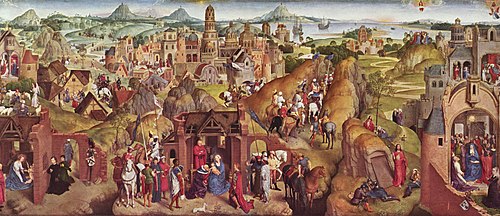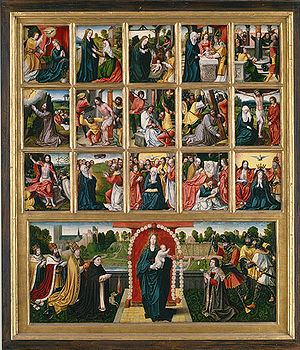Life of the Virgin

The Life of the Virgin, showing narrative scenes from the life of
Scenes shown
The Life of the Virgin sometimes merges into a cycle of the Life of Christ, sometimes includes scenes from the
Important examples whose scenes are listed in the table below, include those in the
The

The total number of scenes was potentially very large up to the early Gothic period; Lafontaine-Dosogne, a leading authority, lists a total of 53 scenes before the Annunciation alone that occur in the art of the West, although only a single example (a 13th-century illuminated manuscript from Germany) containing all of these survives, and very possibly few others ever existed. Seventeen of these scenes preceded the Birth of the Virgin.[3] These apocryphal scenes became much more restricted in the later Middle Ages.
Certain events from the Life were celebrated as feasts by the Church, and others were not; this greatly affected the frequency with which they were depicted. Other Marian devotional practices affected the length and composition of cycles;
Table of scenes
The table below shows whether a scene was the subject of a feast-day in the Western church, and gives the contents of the cycles (described above and below) by: Giotto in the Scrovegni Chapel, a typical Book of hours,[5] the Hours of Catherine of Cleves,[6] the cycle of the "Master of the Louvre Life of the Virgin",[7] Ghirlandajo's Tornabuoni Chapel cycle, and the print cycles of Israhel van Meckenem and Albrecht Dürer.
| Scene | Feast? | Giotto | Bk of Hrs | C of C | Louvre | Ghirla. | Israhel | Dürer |
|---|---|---|---|---|---|---|---|---|
| Expulsion of/Annunciation to Joachim | Both | Ann | Ann | Exp | Exp | Both | ||
| Joachim and Anne Meeting at the Golden Gate | Yes | Yes | Yes | Yes | ||||
| Nativity of Mary | Yes | Yes | Yes | Yes | Yes | Yes | Yes | |
| Presentation of Mary | Yes | Yes | Yes | Two | Yes | Yes | ||
| Marriage of the Virgin | Yes | Yes | Yes | Yes | Yes | Yes | ||
| Annunciation | Yes | Yes | Yes | Yes | Missing? | Yes | Yes | Yes |
Visitation
|
Yes | Yes | Yes | Yes | Yes | Yes | ||
| Nativity of Jesus | Yes | Combined | Yes | Combined | Yes | Combined | Combined | |
| Announcement to the Shepherds | Yes | Yes | ||||||
| Adoration of the Magi | Yes | Yes | Yes | Yes | Yes | Yes | ||
Circumcision of Christ
|
Yes | Yes | Yes | |||||
Presentation of Jesus at the Temple
|
Yes | Yes | Yes | Yes | Yes | Yes | Yes | |
| Flight into Egypt | Yes | Yes, and/or alternative |
Yes | Yes | Yes, plus Rest | |||
| Massacre of the Innocents | Yes | Yes | Yes | Yes | ||||
| Finding in the Temple | Yes | Yes | Yes | Yes | ||||
| Christ taking leave of his Mother | Yes | |||||||
| Crucifixion of Jesus | Yes | Yes | ||||||
| Ascension of Jesus | Yes | Yes | ||||||
| Pentecost | Yes | Yes | ||||||
| Death of the Virgin | Yes | Yes | Combined | Yes | ||||
| Assumption of Mary | Yes | Yes | Yes | |||||
| Coronation of the Virgin | Yes | Yes | Yes | |||||
| Other | Many | 4 | 1 | 1 | ||||
| Total | 16 | 17+ | 8 | 15 | 12 | 9 | 11 | 19 |

The sample above is correct in suggesting that the Annunciation and the Nativity were the only indispensable scenes; the Louvre cycle probably came from an altarpiece with a missing Annunciation as its main panel. The Nativity is always represented, but this may be done by the Nativity itself, the Adoration of the Shepherds, or the Adoration of the Magi – or by a combination of these three. Although the eight scenes for Books of Hours were the standard selection, followed for example by the two examples described by Robert Calkins,[8] it will be noticed that the much longer cycle in the "Hours of Catherine of Cleves" only overlaps with the standard scheme for three scenes. Ghirlandajo has large rectangular spaces to fill, and avoids scenes with only a few participants (and with no opportunity for showy costumes), except for the Annunciation. Christ taking leave of his Mother was a subject new in the 14th century, and only popular from the 15th.
History
The depiction of scenes from the life of the Virgin goes back to almost the earliest days of Christian art; a scene from the church at

Cycles of the Life of Mary were less frequent in the West than the East until the Gothic period. The cycle of the Nativity in the
With the arrival of the
With the decline of the illuminated manuscript and the advent of larger paintings and the single-subject altarpiece, cycles became less important in art, except in print form, but painted cycles by no means died out. A cycle of 16 fairly large paintings by
Gallery
-
The first steps of the Virgin, a common Byzantine subject, rarely seen in the West.Chora Church of Constantinople, 1315-21.
-
German Nativity of Mary, from the 8 scene cycle by the Master of the Life of the Virgin, 1463
-
The Presentation of Mary by Titian
See also
- Castelseprio
- Chora Church– late Byzantine cycle detailed.
Notes
- ^ Probably between 1500 and 1504. Kurth: 27
- ISBN 3-87490-701-5
- ^ Cartlidge and Elliott discuss the composition of cycles at length, with tables pp. 29–32 listing the 53 scenes, after Lafontaine-Dosogne, and the equivalent Eastern cycle.
- ^ Schiller: I,125
- ^ Harthan, p.28
- ^ Plummer, Plates 1–15.
- ^ An unknown Venetian master of ca. 1480. DES SCENES DE LA VIE DE LA VIERGE Joconde database
- ^ Calkins, Robert G. Illuminated Books of the Middle Ages, pp. 310–313, Ithaca, New York: Cornell University Press, 1983.
- ^ Cartlidge and Elliott:36, picture p.34
- ^ Cartlidge and Elliott:32 – they discuss the role of the Apocrypha throughout their chapter on Mary
- ^ Schiller: I 31–32
- ^ Shestack:no.s 38–41
- ^ Shestack:no.s 216–227
- ^ Oberhuber, Konrad in: Jay A. Levinson (ed.) Early Italian Engravings from the National Gallery of Art, National Gallery of Art, Washington (Catalogue), p.48ff, 1973, LOC 7379624
- ^ "Louvre Museum Official Website". cartelen.louvre.fr. Retrieved 2020-07-11.
- ^ This detail is rare outside Parisian ivories of this period, but the whole composition of this triptych is very closely followed in many works of similar date (e.g. Thompson Collection, Ottawa)
References
- David R. Cartlidge, James Keith Elliott, Art and the Christian Apocrypha, pp. 21–46, 2001, Routledge, London; ISBN 0-415-23391-7
- Harthan, John, The Book of Hours, p. 28, 1977, Thomas Y Crowell Company, New York, ISBN 0-690-01654-9
- Kurth, Willi, The Complete Woodcuts of Albrecht Durer, Dover Books, New York, 1963
- Plummer, John, The Hours of Catherine of Cleves, Plates 1–15, New York, George Braziller, 1966
- ISBN 0-85331-270-2
- Shestack, Alan; Fifteenth century Engravings of Northern Europe; 1967, National Gallery of Art, Washington (Catalogue), LOC 67-29080
Further reading
- Lafontaine-Dosogne, Jacqueline. Iconographie de l’enfance de la Vierge dans l’Empire byzantin et en Occident (2 vols, revised edn.), Bruxelles, Palais des académies, 1992, ISBN 2-8031-0092-4


![14th-century French ivory triptych showing the Annunciation, Visitation, Adoration of the Magi, Nativity (with Joseph holding the baby while Mary sleeps),[16] Presentation.](http://upload.wikimedia.org/wikipedia/commons/thumb/a/a4/Ivory_tabernacle_Louvre_OA2587.jpg/108px-Ivory_tabernacle_Louvre_OA2587.jpg)


